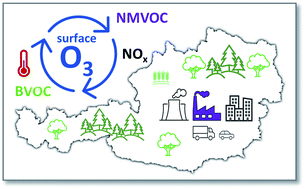An analysis of 30 years of surface ozone concentrations in Austria: temporal evolution, changes in precursor emissions and chemical regimes, temperature dependence, and lessons for the future†
Abstract
Despite substantial reductions in anthropogenic emissions of nitrogen oxides (NOx) and non-methane volatile organic compounds (NMVOCs) in Austria over the 30 year time period 1990–2019, summertime surface ozone (O3) concentrations still exceed frequently and over wide areas the ozone maximum 8 hour mean target value for the protection of human health. We present a detailed analysis of in situ observations of O3 and NOx to (1) disentangle the main processes propelling O3 formation such as precursor emissions and meteorology and (2) quantify the impact of NOx reductions and (3) estimate the effect of climate warming. The temperature sensitivity of surface O3 production is assessed separately for NOx and VOC limited regimes. The temperature sensitivity of ozone increases with temperature in spring and summer. On average, the evaluated absolute values of the sensitivities are a factor of 2.5 larger in summer than in spring. The analysis of ambient O3 burdens during hot summers indicates that rising temperatures in a warming climate might largely offset the benefit of future emission reductions. MAX-DOAS formaldehyde (HCHO) measurements in Vienna from 2017 to 2019 are used as a proxy for VOC emissions. The seasonal and the temperature dependence of the observed HCHO mixing ratios indicate that biogenic VOCs (BVOCs) are the dominant source of hydrocarbons in the urban setting during the ozone season. The result agrees well with VOC emission estimates that show BVOCs to be the dominant VOC source in Austria since the early 2000s. Accordingly, anthropogenic NOx emission reductions remain, outside of urban cores, the most effective instrument for policymakers to lower surface ozone concentrations in the short term.

- This article is part of the themed collection: The role of tropospheric ozone in atmospheric processes, health and climate - Topic Highlight


 Please wait while we load your content...
Please wait while we load your content...